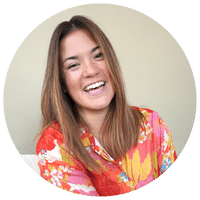
Embarking on a journey with intuitive eating shifts the landscape of restrictions and guilt around food to freedom and self-compassion. One cornerstone of this liberating approach is the ‘all foods fit’ philosophy, a radical notion that invites all foods to the table with equal grace.
The ‘all foods fit’ philosophy doesn’t just challenge conventional dieting—it turns in on its head by encouraging you to give yourself permission to eat the foods you love and crave no matter how they have been stigmatized by diet culture. As you peel away the layers of old dietary rules that no longer serve you, you can discover a more balanced, fulfilling way of eating that celebrates all foods without guilt.
In this article, you’ll learn how embracing the ‘all foods fit’ philosophy within the intuitive eating framework can guide you towards a more balanced, joyful, and nourishing way of eating. We’ll debunk some interesting criticism of the ‘all foods fit’ model and reveal some practical tips for applying this philosophy to your life.
Why All Foods Fit into Intuitive Eating
The ‘all foods fit’ philosophy is a core component of intuitive eating, a holistic approach to nutrition that encourages listening to your body rather than adhering to external diet rules. Intuitive eating promotes the idea that all foods can be enjoyed in moderation, without guilt or strict limitations. This philosophy helps foster a positive relationship with food, where choices are driven by internal signals of hunger and satiety, as well as personal preferences, rather than fear or restriction.
A key aspect of the ‘all foods fit’ approach is breaking down food hierarchies and embracing food neutrality. This means moving away from labeling foods as ‘good’ or ‘bad’ and instead seeing all foods as having a place in your diet. By doing so, you can enjoy a wide range of foods without feeling guilty or anxious, which can lead to a more balanced and satisfying eating experience.
When All Foods Fit, Does It Lead to Healthy Choices?
Many people like the idea of intuitive eating but worry about whether or not it’s healthy. Especially in light of concepts like ‘all foods fit,’ it begs the question: is intuitive eating healthy, and can all foods really fit?
The ‘all foods fit’ concept, when embraced within the framework of moderation and balance, can indeed lead to healthy outcomes. The Academy of Nutrition and Dietetics emphasizes that the overall pattern of what you eat is more crucial than focusing on individual foods.[1]
By incorporating a variety of foods in appropriate portions—sizes appropriate for your needs, not the needs deemed worthy by diet culture—you can create a balanced diet that includes all food groups without labeling any as “good” or “bad.” Studies have shown that it’s possible to include low-nutrient foods (e.g. processed foods, sweets) in up to one-fifth of your diet and still maintain optimal nutrition.[2]
The key is to balance these low-nutrient foods (think: cookies, chips) with high-nutrient options like fruits, vegetables, whole grains, dairy, and fish. This balance ensures that you’re not only satisfying your taste preferences but also meeting your body’s nutritional needs.
Criticism Debunked for the All Foods Fit Philosophy
Some critics argue that the ‘all foods fit’ philosophy could lead to poor health outcomes by allowing the consumption of less nutritious foods. However, studies have demonstrated that this approach can still support a healthy diet.
The Academy of Nutrition and Dietetics emphasizes the importance of the overall dietary pattern rather than focusing on individual foods.[1] Furthermore, research has shown that including foods low in nutrients (i.e. so-called ‘junk foods’) in moderation does not compromise nutritional adequacy, provided that the majority of the diet is composed of nutrient-dense foods.[2]
Sugar Addiction and Emotional Eating
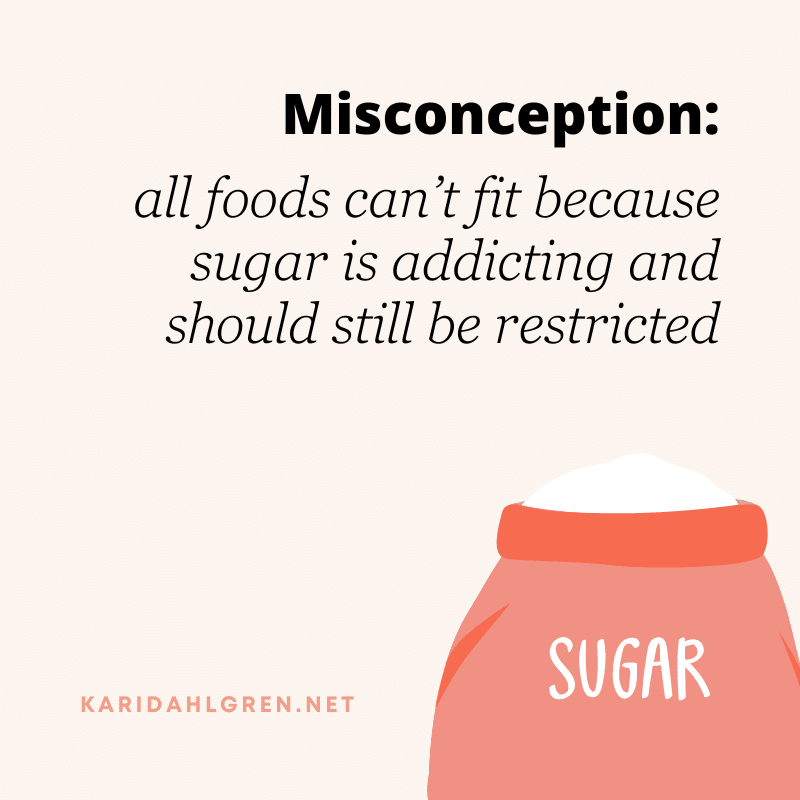
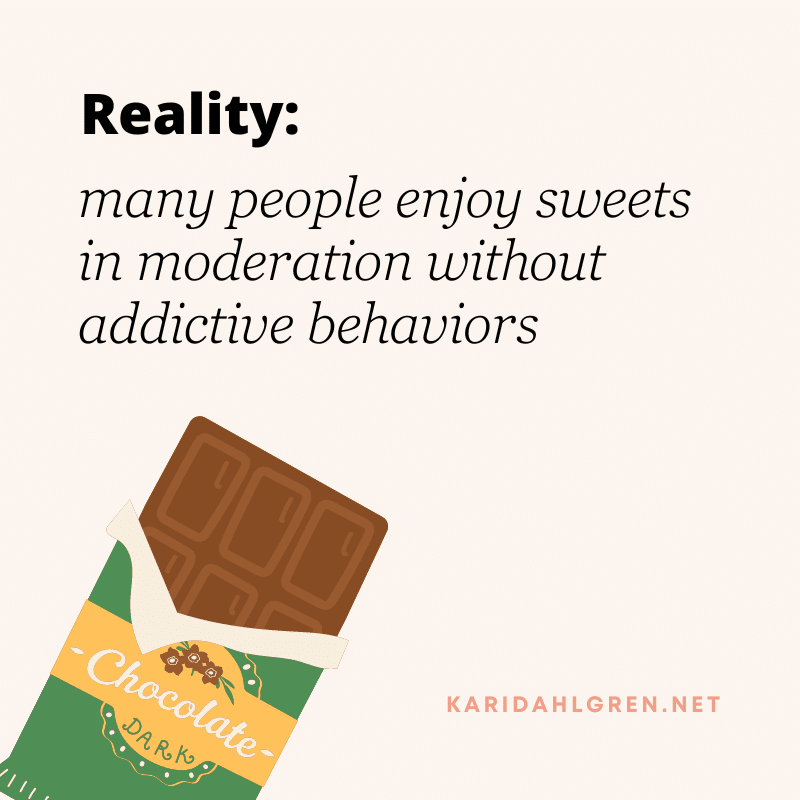
The intersection of intuitive eating and sugar cravings is riddled with strong opinions. Some people criticize the ‘all foods fit’ model because of sugar addiction, which suggests that sugar has addictive properties that can lead to overconsumption. While it’s true that sugar can have addictive qualities[3], this perspective doesn’t give the individual nearly enough credit.
There are many people who can have one bite of something sweet and stop, which means that while sugar can be addicting, many people can overcome the physical properties of sugar. This begs the question, what’s the difference between a person who feels addicted to sugar and another person who can enjoy sweets in moderation?
The answer is different for everyone and lies in a multitude of factors—all of which are relevant for the ‘all foods fit’ philosophy. For instance, dietary restriction and deprivation is a factor, as making sweets off-limits increases preoccupation and desire for them.[4] Furthermore, when sugar cravings are coupled with emotional eating, it can make it much more difficult to stop at satiety without addressing the psychology behind overeating.
Can Processed Foods Actually Fit into a Balanced Diet?
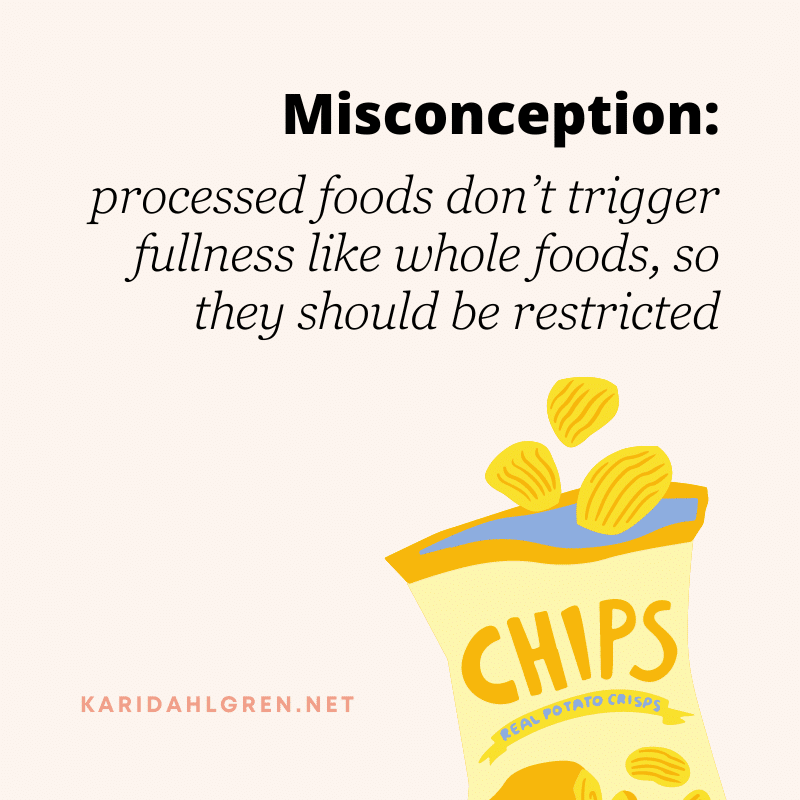
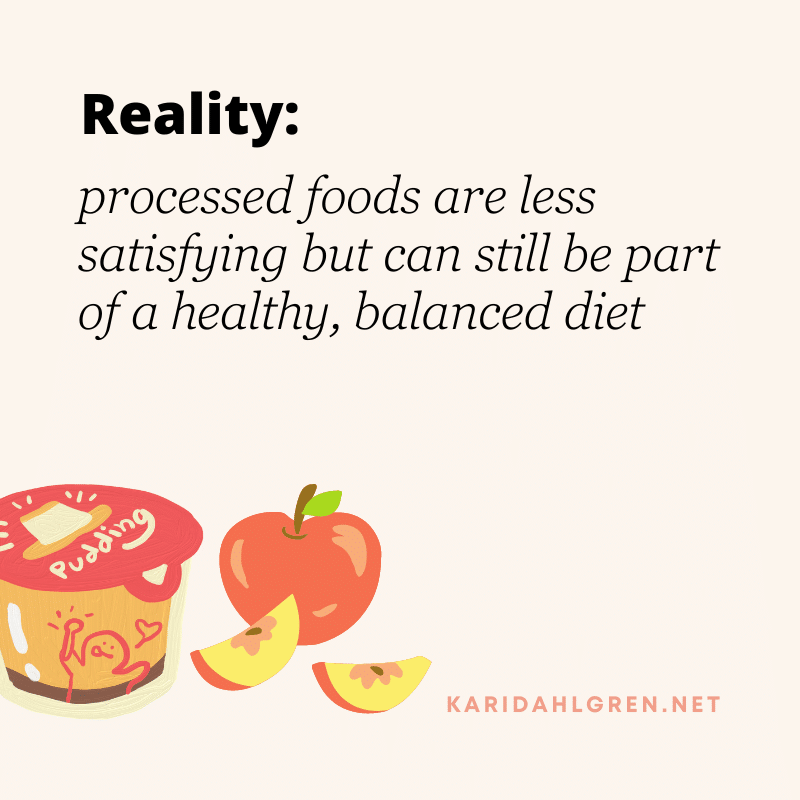
Critics also argue that processed foods don’t trigger fullness in the same way as whole foods, potentially leading to overeating through the ‘all foods fit’ philosophy. It’s valid that processed foods are metabolized differently and may not be as satiating[5], [6]; but this doesn’t mean all people are powerless to them.
Have you ever watched someone eat a normal serving of potato chips out of a family size bag and stop? It happens all the time. This begs the same question: what’s the difference between someone who can enjoy processed foods in moderation versus someone that struggles with eating past fullness? The answer could involve the less-than-satiating effect of processed foods, but it’s also influenced by many other factors such as emotional eating, stress, and dieting.
Studies show that restrictive dieting is linked with overeating as the body compensates for reduced food intake by ramping up hunger hormones.[7], [8] In this light, if a restrictive dieter overconsumes processed foods, it could be partially influenced by the less-satiating effects of the processed food, but it’s also strongly influenced by the body’s biological drive to motivate eating in the face of caloric restriction.[9]
How to Make Sure that All Foods Fit with Intuitive Eating
Now that you understand how all foods fit into intuitive eating, and that there’s room for sugar and processed foods in a balanced diet—and it doesn’t have to result in overeating—let’s dig into some practical tips to help you apply the ‘all foods fit’ philosophy to your life.
1. Let Go of Restrictive Dieting
Embracing the ‘all foods fit’ philosophy with intuitive eating starts with letting go of restrictive dieting. Dieting often leads to feelings of moral inferiority when eating “bad” foods and moral superiority when eating “good” foods.[10] In turn, this can heighten feelings of guilt and shame around eating.
However, studies show that intuitive eaters, who embrace a more flexible approach to eating, actually have better dietary habits than dieters.[11] Intuitive eating encourages listening to your body’s hunger and fullness cues, making food choices based on satisfaction and nourishment rather than strict rules.
This approach leads to a more balanced and varied diet, which often leads to a higher intake of fruits and vegetables naturally—without the need for any food rules to encourage it.[12] By embracing ‘all foods fit’ within the context of intuitive eating, you can cultivate a healthier relationship with food, one that is based on nourishment, pleasure, and respect for your body’s needs.
2. Avoid “Entitlement Eating”
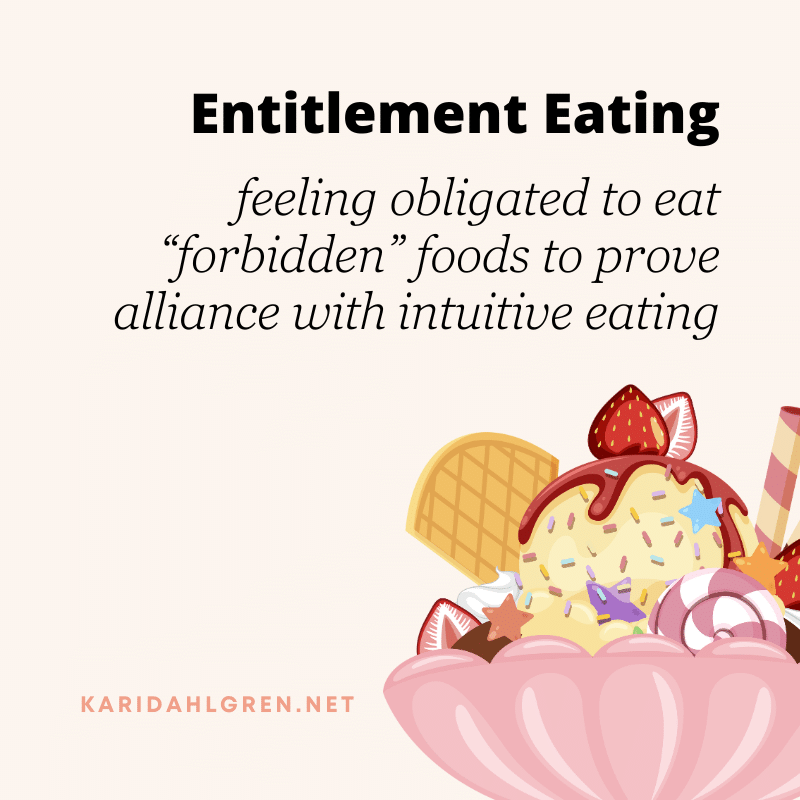
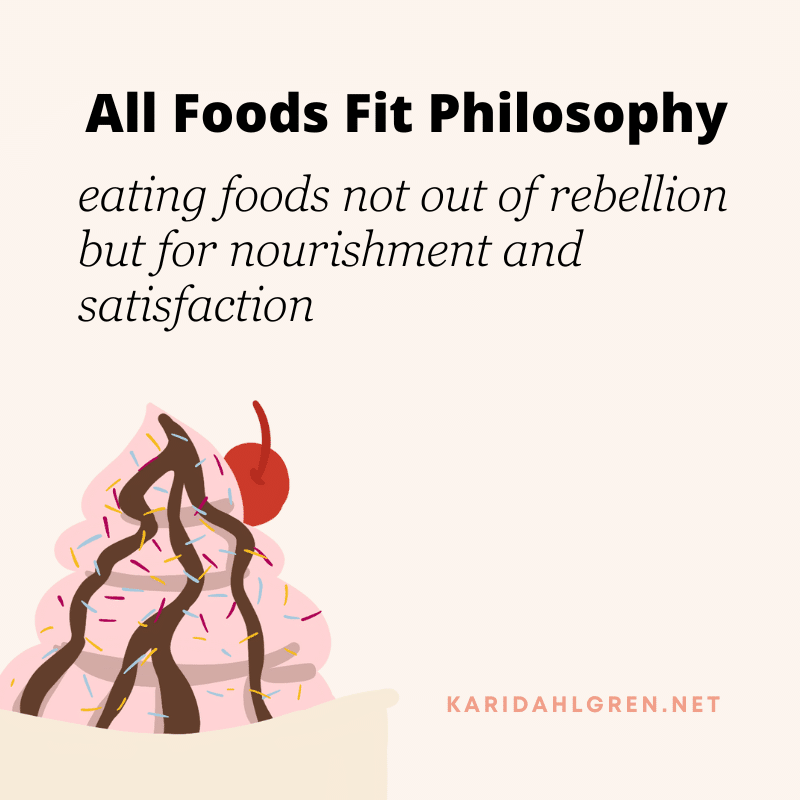
When transitioning away from restriction, it’s common to go through several stages of giving up dieting, and one of these may involve a sense of entitlement or even obligation to eat previously “forbidden foods.”
For example, if you’ve been restricting sweets and then decide to embrace intuitive eating, you might feel pressure to indulge in full-fat dairy desserts to prove you’re no longer dieting. However, choosing a dairy-free option like vegan ice cream can be a valid decision based on personal wellness and food sensitivities, not a sign of restriction.
To avoid the trap of entitlement eating, consider these tips:
- Reflect on Your Choices: Ask yourself if you’re choosing a food because you genuinely enjoy it and it makes you feel good, or if you’re eating it out of a sense of rebellion against past diet rules. Rebellion is one of the stages of giving up dieting, but it’s a stage to move through, not remain stuck in.
- Honor Your Body’s Needs: Listen to your body’s signals and choose foods that satisfy both your taste buds and your physical well-being. Satisfaction is an important element of eating.
- Embrace Variety: Remember that intuitive eating is about balance and variety. It’s not an all-or-nothing approach. You can enjoy a wide range of foods, including those considered “indulgent,” without feeling obligated to eat them.
- Let Go of Judgment: Release any judgment you have about certain foods being “good” or “bad” and embrace the ‘all foods fit’ philosophy instead. This is especially important if you really love food and feel like you have to battle against your own desires. Food choices don’t define your worth or your commitment to intuitive eating.
By staying mindful of your motivations and choices, you can navigate the ‘all foods fit’ philosophy without falling into the trap of entitlement eating. This approach allows you to enjoy all foods in a way that honors both your physical and emotional well-being.
3. Find Confidence in the ‘All Foods Fit’ Philosophy by Addressing Emotional Eating
Many people worry about the healthiness of intuitive eating, often because of past experiences with overeating. Taking steps to overcome any emotional eating tendencies can help you embrace the ‘all foods fit’ philosophy with more confidence, knowing that you can enjoy indulgent foods without overindulging.
An excellent tool for addressing emotional eating is my Stop, Drop, & Feel technique, which helps you increase tolerance for uncomfortable emotions through urge surfing. When you feel the urge to eat past fullness, promise yourself that you can still eat what appeals to you (which honors the element of permission). Then, drop into your body and hold space for any emotions that emerge.
As you train in sitting still with discomfort, you will improve your tolerance for uncomfortable emotions and naturally reduce the desire to buffer with overeating. Incorporating the SDF technique into your journey with intuitive eating allows you to eat the foods you love and crave without overeating, ensuring that all foods fit in a way that respects both your body’s hunger signals and your emotional well-being.
For more emotional eating tips: Take my quiz to discover your eating psychology STRENGTH. Even if you constantly feel tempted around food, we all have a strength—and I bet I can guess yours. Click here to take the quiz now.
4. Eat Based on Body Signals, Not Visuals
Finally, mindful eating is a foundational element in ensuring that all foods fit within the intuitive eating framework. Mindful eating emphasizes the importance of being fully present and engaged with the eating experience, focusing on the senses and acknowledging the body’s hunger and fullness cues without judgment. This practice becomes especially pertinent when considering how we often eat based on visual cues rather than internal signals of hunger and satiety.
For example, eating directly from a family-size bag of chips can lead us to consume more than we might if we were paying close attention to our hunger and fullness. Furthermore, if you’re someone that relates to feeling less satisfied by processed foods but still want to enjoy them through the ‘all foods fit’ philosophy, it can be helpful to dish out a serving and reassess hunger and fullness afterwards.
5. Emphasize Nutritional Diversity
Nutritional diversity involves incorporating a wide variety of foods into your diet to ensure you’re getting a broad spectrum of nutrients, vitamins, and minerals. This concept aligns with intuitive eating by encouraging individuals to listen to their bodies and explore a range of food options that satisfy both taste preferences and nutritional needs.
Here are some tips for incorporating nutritional diversity:
- Try New Foods Regularly: Make it a point to try new foods or recipes that incorporate different ingredients. This not only adds variety to your diet but can also expand your palate. It’s also a great tip during moments when you’re hungry but nothing sounds good.
- Balance Your Plate: Aim for a colorful plate at meals, including a variety of food groups. This visual cue can help ensure you’re getting a mix of nutrients.
- Listen to Your Body: Pay attention to how different foods make you feel. Your body will give you cues about what it needs, such as a craving for carbs when your body needs more energy.
By integrating the concept of nutritional diversity into the ‘all foods fit’ philosophy, you can enrich your intuitive eating practice, ensuring it supports both your enjoyment of food and your nutritional well-being.
Finding Optimal Wellness with the All Foods Fit Philosophy
The ‘all foods fit’ philosophy is a liberating approach to eating and wellness. It moves away from restrictive labels and embraces a balanced, mindful relationship with food. By listening to your body’s cues and embracing food neutrality, you learn to enjoy a wide range of foods without guilt.
Incorporating nutritional diversity ensures your diet is not only enjoyable but also nourishing. Ultimately, this philosophy isn’t just about what you eat; it’s about fostering a peaceful, positive relationship with food and embracing the joy of eating in a way that supports your overall well-being.
